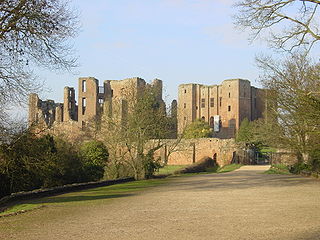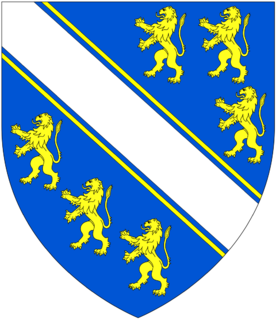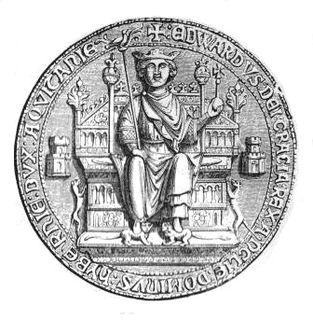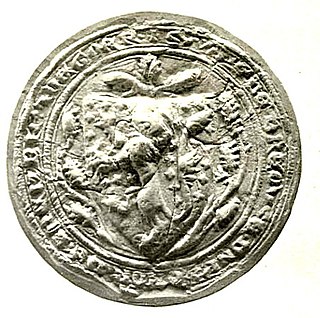Related Research Articles

The Dictum of Kenilworth, issued on 31 October 1266, was a pronouncement designed to reconcile the rebels of the Second Barons' War with the royal government of England. After the baronial victory at the Battle of Lewes in 1264, Simon de Montfort took control of royal government, but at the Battle of Evesham the next year Montfort was killed, and King Henry III restored to power. A group of rebels held out in the stronghold of Kenilworth Castle, however, and their resistance proved difficult to crush.

Magna Carta Libertatum, commonly called Magna Carta, is a royal charter of rights agreed to by King John of England at Runnymede, near Windsor, on 15 June 1215. First drafted by Archbishop of Canterbury, Cardinal Stephen Langton, to make peace between the unpopular king and a group of rebel barons, it promised the protection of church rights, protection for the barons from illegal imprisonment, access to swift justice, and limitations on feudal payments to the Crown, to be implemented through a council of 25 barons. Neither side stood behind their commitments, and the charter was annulled by Pope Innocent III, leading to the First Barons' War.

Edward I, also known as Edward Longshanks and the Hammer of the Scots, was King of England from 1272 to 1307. Before his accession to the throne, he was commonly referred to as The Lord Edward. The first son of Henry III, Edward was involved from an early age in the political intrigues of his father's reign, which included an outright rebellion by the English barons. In 1259, he briefly sided with a baronial reform movement, supporting the Provisions of Oxford. After reconciliation with his father, however, he remained loyal throughout the subsequent armed conflict, known as the Second Barons' War. After the Battle of Lewes, Edward was hostage to the rebellious barons, but escaped after a few months and defeated the baronial leader Simon de Montfort at the Battle of Evesham in 1265. Within two years the rebellion was extinguished and, with England pacified, Edward joined the Ninth Crusade to the Holy Land. He was on his way home in 1272 when he was informed that his father had died. Making a slow return, he reached England in 1274 and was crowned at Westminster Abbey.

Roger Bigod was 5th Earl of Norfolk.

Henry de Bohun, 1st Earl of Hereford of Pleshy Castle in Essex, was an Anglo-Norman nobleman who became Hereditary Constable of England from 1199.

Edmund Fitzalan, 2nd Earl of Arundel was an English nobleman prominent in the conflict between King Edward II and his barons. His father, Richard Fitzalan, 1st Earl of Arundel, died in 1302, while Edmund was still a minor. He therefore became a ward of John de Warenne, Earl of Surrey, and married Warenne's granddaughter Alice. In 1306 he was styled Earl of Arundel, and served under Edward I in the Scottish Wars, for which he was richly rewarded.
John de Halton, also called John de Halghton, was an English priest and Bishop of Carlisle from 1292 to 1324.

Humphrey (VI) de Bohun, 3rd Earl of Hereford and 2nd Earl of Essex, was an English nobleman known primarily for his opposition to King Edward I over the Confirmatio Cartarum. He was also an active participant in the Welsh Wars and maintained for several years a private feud with the earl of Gloucester. His father, Humphrey (V) de Bohun, fought on the side of the rebellious barons in the Barons' War. When Humphrey (V) predeceased his father, Humphrey (VI) became heir to his grandfather, Humphrey (IV). At Humphrey (IV)'s death in 1275, Humphrey (VI) inherited the earldoms of Hereford and Essex. He also inherited major possessions in the Welsh Marches from his mother, Eleanor de Braose.
The Oxford Parliament (1258), also known as the Mad Parliament and the First English Parliament, assembled during the reign of Henry III of England. It was established by Simon de Montfort, 6th Earl of Leicester. The parlour or prolocutor (Speaker) was Peter de Montfort under the direction of Simon de Montfort. Simon de Montfort led the Parliament and the entire country of England for 18 months, from 1264 until his death at the Battle of Evesham.
Gilbert de Clare, 8th Earl of Gloucester, 7th Earl of Hertford was an English nobleman and military commander in the Scottish Wars. In contrast to most English earls at the time, his main focus lay in the pursuit of war rather than in domestic political strife. He was the son of Gilbert de Clare, 7th Earl of Gloucester, and Joan of Acre, daughter of King Edward I. The older Gilbert died when his son was only four years old, and the younger Gilbert was invested with his earldoms at the young age of sixteen. Almost immediately, he became involved in the defence of the northern border, but later he was drawn into the struggles between Edward II and some of his barons. He was one of the Lords Ordainers who ordered the expulsion of the king's favourite Piers Gaveston in 1311. When Gaveston was killed on his return in 1312, Gloucester helped negotiate a settlement between the perpetrators and the king.
Events from the 1300s in England.
Events from the 1290s in England.
Events from the 1220s in England.

John de Vere, 7th Earl of Oxford was the nephew and heir of Robert de Vere, 6th Earl of Oxford who succeeded as Earl of Oxford in 1331, after his uncle died without issue.
John de Ferrers, 1st Baron Ferrers of Chartley was the son of Robert de Ferrers, 6th Earl of Derby and Alianore de Bohun, daughter of Humphrey de Bohun and Eleanor de Braose, and granddaughter of Humphrey de Bohun, 2nd Earl of Hereford. He was both Seneschal of Gascony and Lieutenant of Aquitaine in 1312, the year of his death.
Adam de Stratton was a royal moneylender, administrator and clergyman under Edward I of England. He advanced professionally through the patronage of the earls of Devon, and became Chamberlain of the Exchequer and steward of Isabella, Countess of Devon. At the same time he made himself an enormous fortune through moneylending, primarily by acquiring debts from Jewish moneylenders. His business methods were dubious, and often involved various illegal activities. In 1290 he fell victim to an investigation of corruption in the royal administration, and from 1292 until his death—no later than 1294—he was held in prison. Stratton has been called by a modern historian "the greatest and probably the most unscrupulous of thirteenth-century money lenders, who eventually met the fate he deserved."

The Boulogne agreement was a document signed by a group of English magnates in 1308, concerning the government of Edward II. After the death of Edward I in 1307, discontent soon developed against the new king. This was partly due to lingering problems from the previous reign, but also related to issues with Edward II himself. Particularly his abandonment of the Scottish Wars and his patronage of the unpopular Piers Gaveston caused discontent. Drawn up in Boulogne-sur-Mer during the king's nuptials, the document vaguely asserted the signatories' duty to guard the rights of the Crown. Three months later, the agreement was the basis for another document, justifying opposition to the king. This latter document, the so-called Declaration of 1308, is notable for its use of the "doctrine of capacities": the distinction between the person of the King and the institution of the Crown.

William de Braose was the second Baron Braose, as well as Lord of Gower and Lord of Bramber. He was held as a hostage after being captured in 1264 during the Second Barons' War and records of some of his childhood expenses survive from his time as a hostage. He first entered royal service in 1286 and, in 1291, he succeeded his father as baron. He continued in royal military service, serving in Scotland as well as in Wales. Protracted disputes over his lands embroiled him throughout his life and at the end of his life helped spark a revolt against King Edward II of England's favourites, the Despensers. He married twice, and his heirs were his daughter Aline and his grandson John de Bohun.
The English invasion of Scotland of 1298 was a military campaign undertaken by Edward I of England in retaliation to a Scottish uprising in 1297, the defeat of an English army at the Battle of Stirling Bridge and Scottish raids into Northern England.
References
- 1 2 Keen, Maurice (1973). England in the Late Middle Ages. London: Mathuen. p. 36. ISBN 0-416-75990-4.
- ↑ Prestwich, Michael (1972). War, Politics and Finance under Edward I. London: Faber and Faber. p. 179. ISBN 0-571-09042-7.
- ↑ Fritze, Ronald H.; William Baxter Robison (2002). "Remonstrances of 1297". Historical dictionary of late medieval England, 1272-1485. Westport, London: Greenwood Publishing Group. pp. 462–34. ISBN 0-313-29124-1 . Retrieved 2009-04-11.
- ↑ Prestwich (1972), p. 251.
- ↑ Prestwich, Michael (1997). Edward I (updated ed.). New Haven: Yale University Press. p. 422. ISBN 0-300-07209-0.
- ↑ Powicke, F. M. (1962). The Thirteenth Century: 1216-1307 (2nd ed.). Oxford: Clarendon Press. p. 682.
- ↑ Prestwich (1997), p. 421.
- ↑ Waugh, Scott L. (2004). "Bohun, Humphrey (VI) de, third earl of Hereford and eighth earl of Essex (c.1249–1298)". Oxford Dictionary of National Biography. Oxford: Oxford University Press. doi:10.1093/ref:odnb/2776.
- ↑ Prestwich, Michael (2007). Plantagenet England: 1225-1360 (new ed.). Oxford: Oxford University Press. p. 169. ISBN 0-19-822844-9.
- ↑ Prestwich (1997), p. 425.
- ↑ Powicke (1962), p. 683
- ↑ Prestwich (2007), p. 170.
- ↑ Morris, Marc (2005). The Bigod earls of Norfolk in the Thirteenth Century. Woodbridge: Boydell Press. p. 166. ISBN 1-84383-164-3.